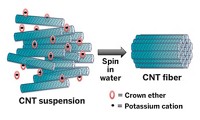Advertisement
Grab your lab coat. Let's get started
Welcome!
Welcome!
Create an account below to get 6 C&EN articles per month, receive newsletters and more - all free.
It seems this is your first time logging in online. Please enter the following information to continue.
As an ACS member you automatically get access to this site. All we need is few more details to create your reading experience.
Not you? Sign in with a different account.
Not you? Sign in with a different account.
ERROR 1
ERROR 1
ERROR 2
ERROR 2
ERROR 2
ERROR 2
ERROR 2
Password and Confirm password must match.
If you have an ACS member number, please enter it here so we can link this account to your membership. (optional)
ERROR 2
ACS values your privacy. By submitting your information, you are gaining access to C&EN and subscribing to our weekly newsletter. We use the information you provide to make your reading experience better, and we will never sell your data to third party members.
Materials
Quickie Method For High-Quality Graphene
Carbon Materials: Microwaving suspensions of graphite in an ionic liquid produces pristine form of ultrathin carbon
by Mitch Jacoby
August 17, 2015
| A version of this story appeared in
Volume 93, Issue 32
Materials chemists have found a quick, high-yield approach for producing single sheets of defect-free graphene by adding powdered graphite to an ionic liquid and subjecting the suspension to microwave irradiation (Nat. Chem. 2015, DOI: 10.1038/nchem.2315). Graphene’s potential use in advanced microelectronics applications has led researchers to devise numerous ways of obtaining the ultrathin carbon material. For example, high-quality graphene sheets can be produced by exfoliating graphite flakes by hand and by growing graphene via vapor-deposition techniques. But those methods have low yields and can be costly. In contrast, liquid-phase exfoliation of graphite with oxidizers and acids followed by a reduction step can inexpensively produce large quantities of an oxidized form of graphene—so-called reduced graphene oxide. But that material is generally pocked with defects, and it contains a variety of functional groups that render it quite different from pristine graphene. Takuzo Aida of the University of Tokyo and coworkers have now demonstrated that microwaving graphite with an oligomeric ionic liquid (IL2PF6 or IL4PF6, shown) converts almost all of the starting material to a nearly defect-free form of graphene in just 30 minutes.



Join the conversation
Contact the reporter
Submit a Letter to the Editor for publication
Engage with us on Twitter